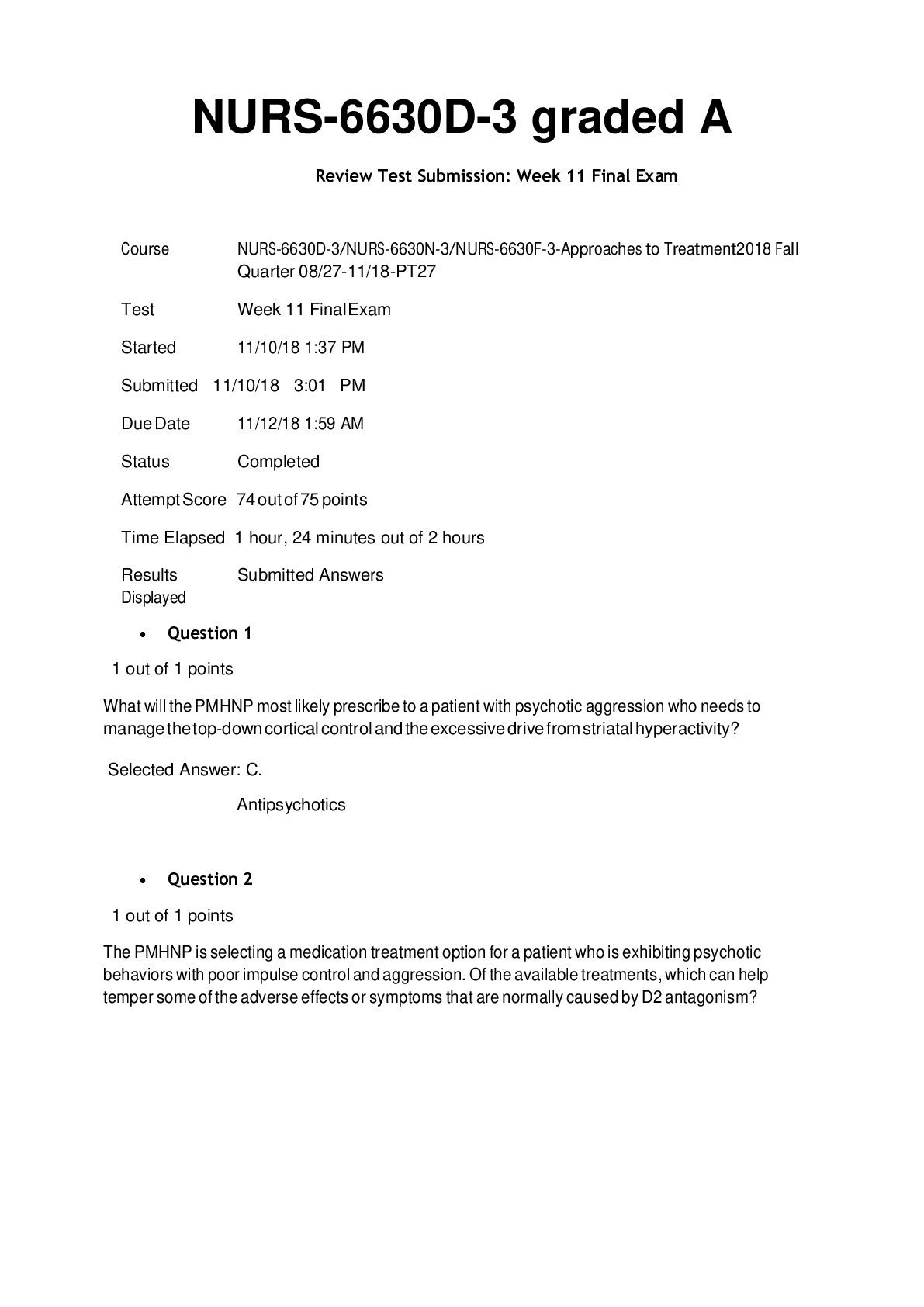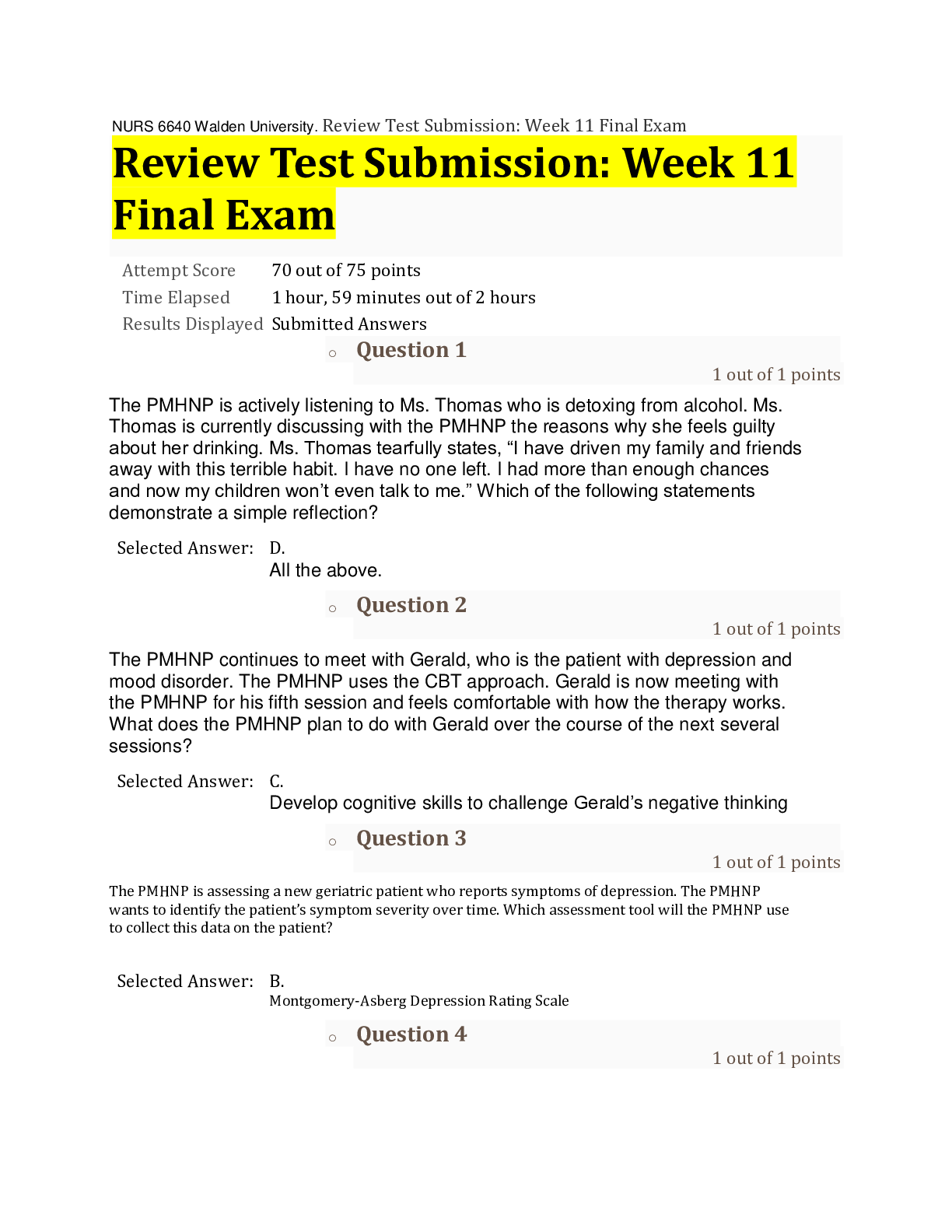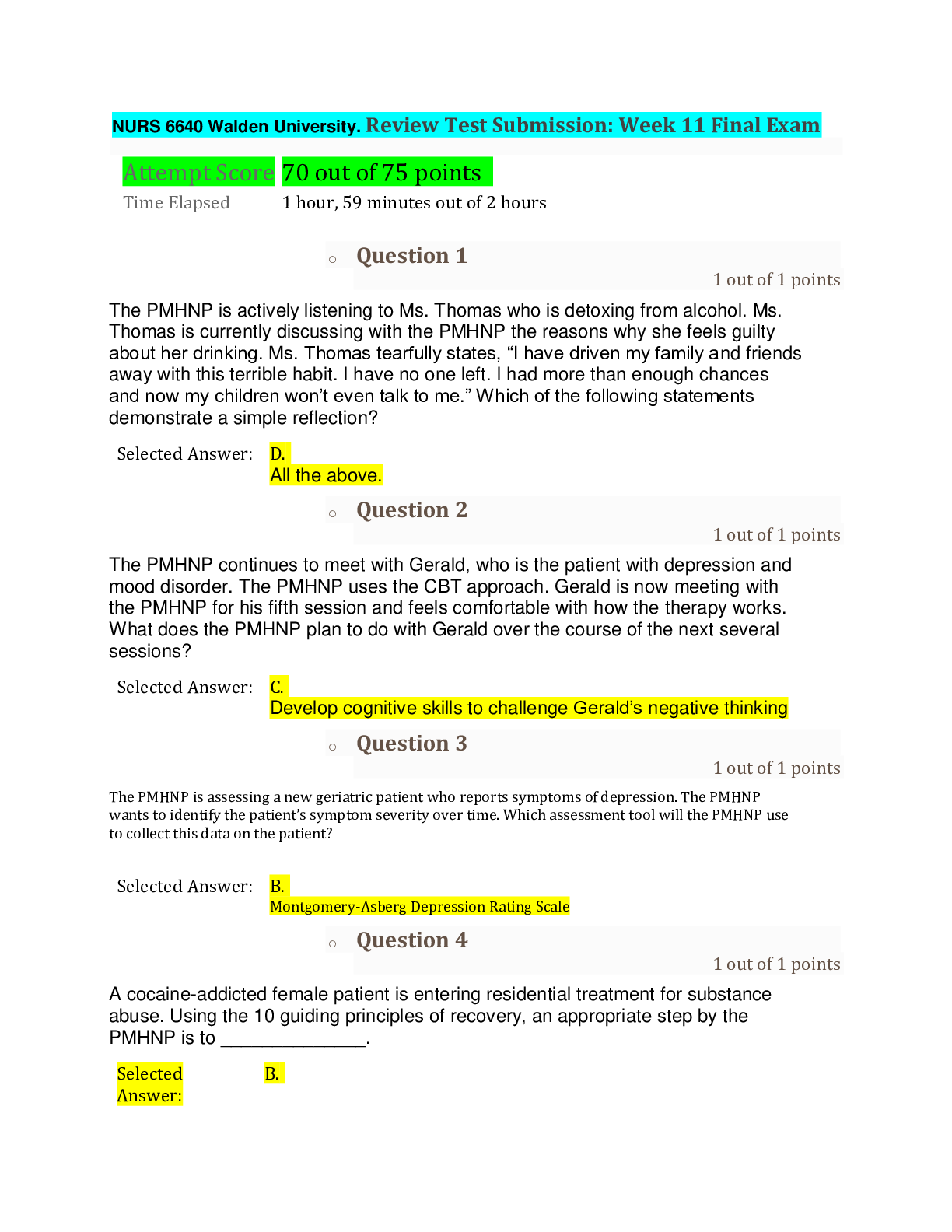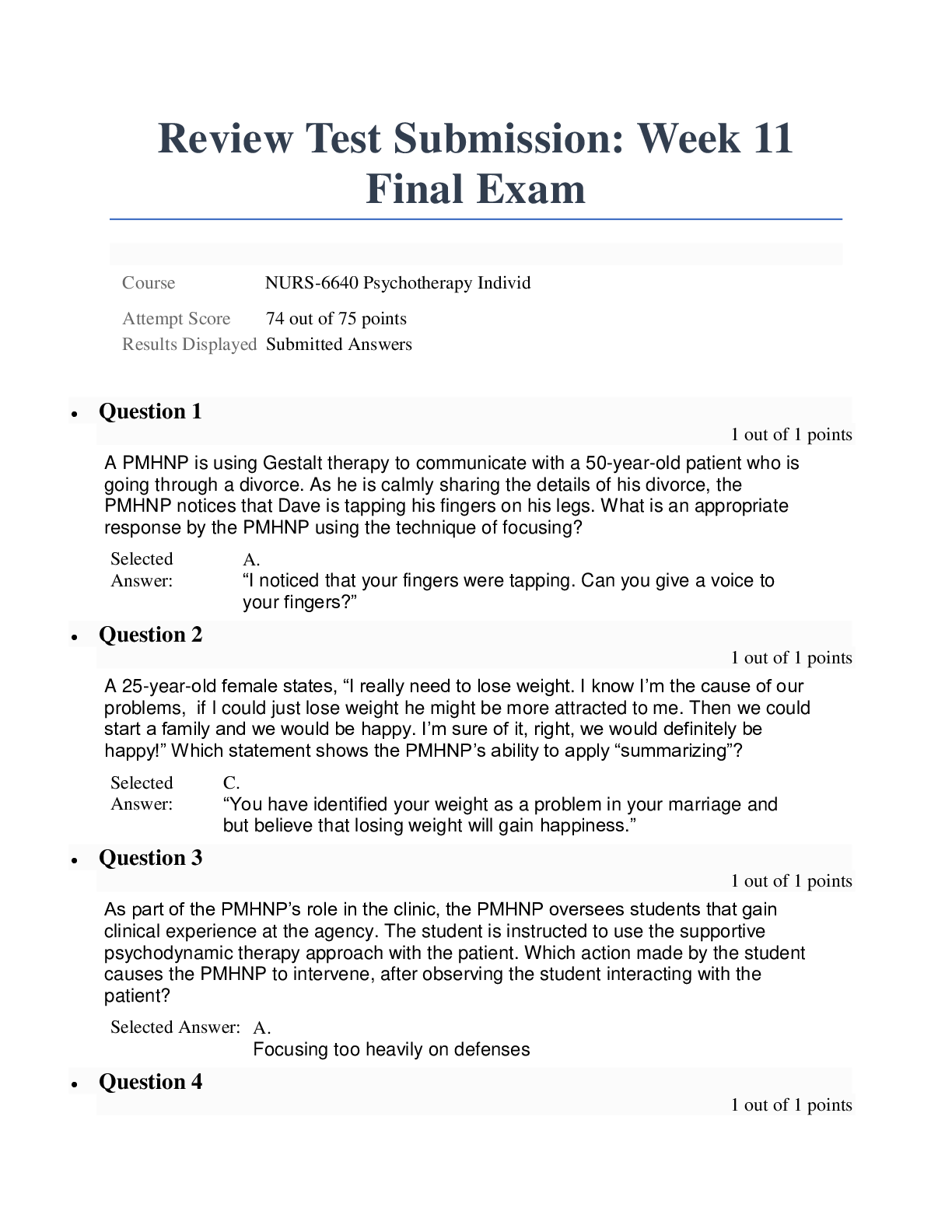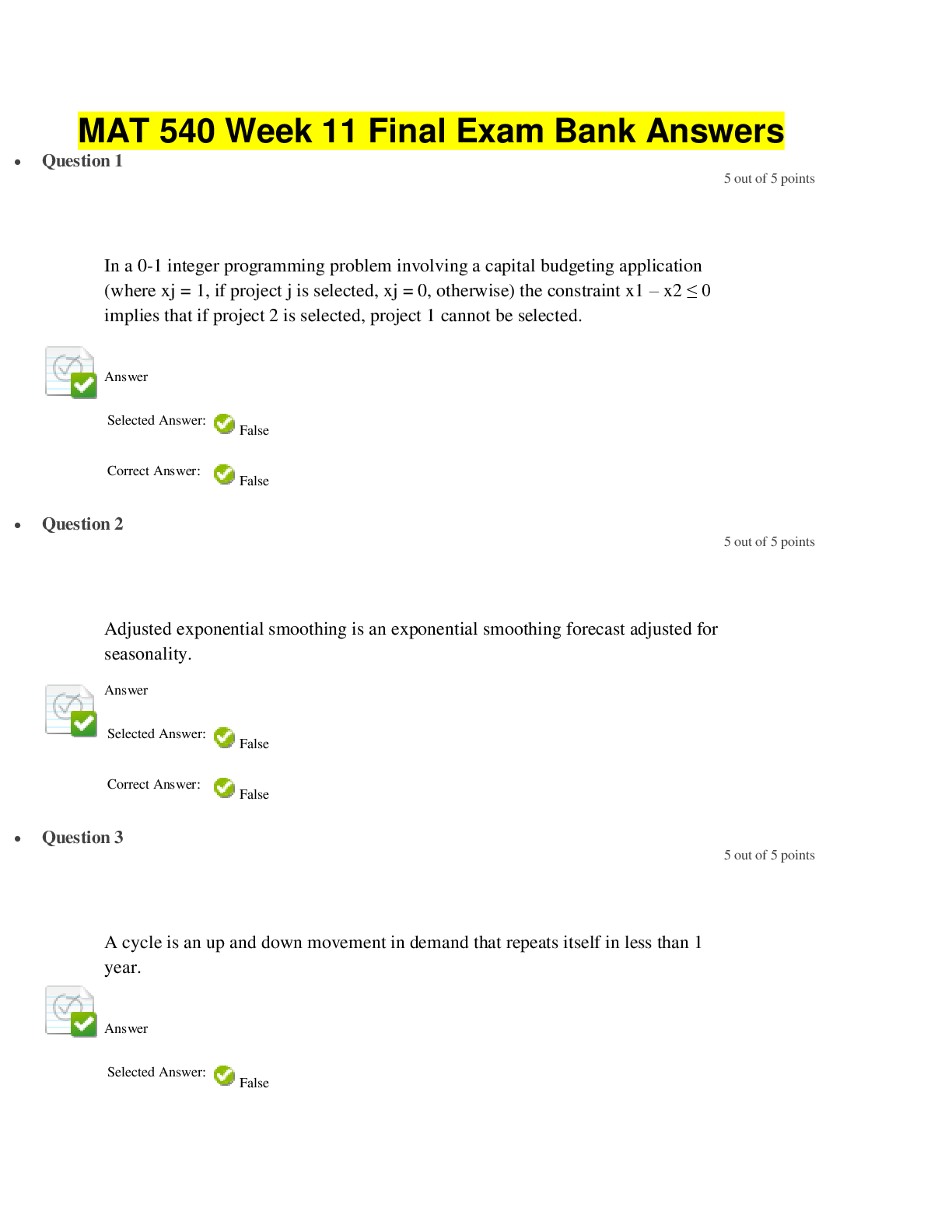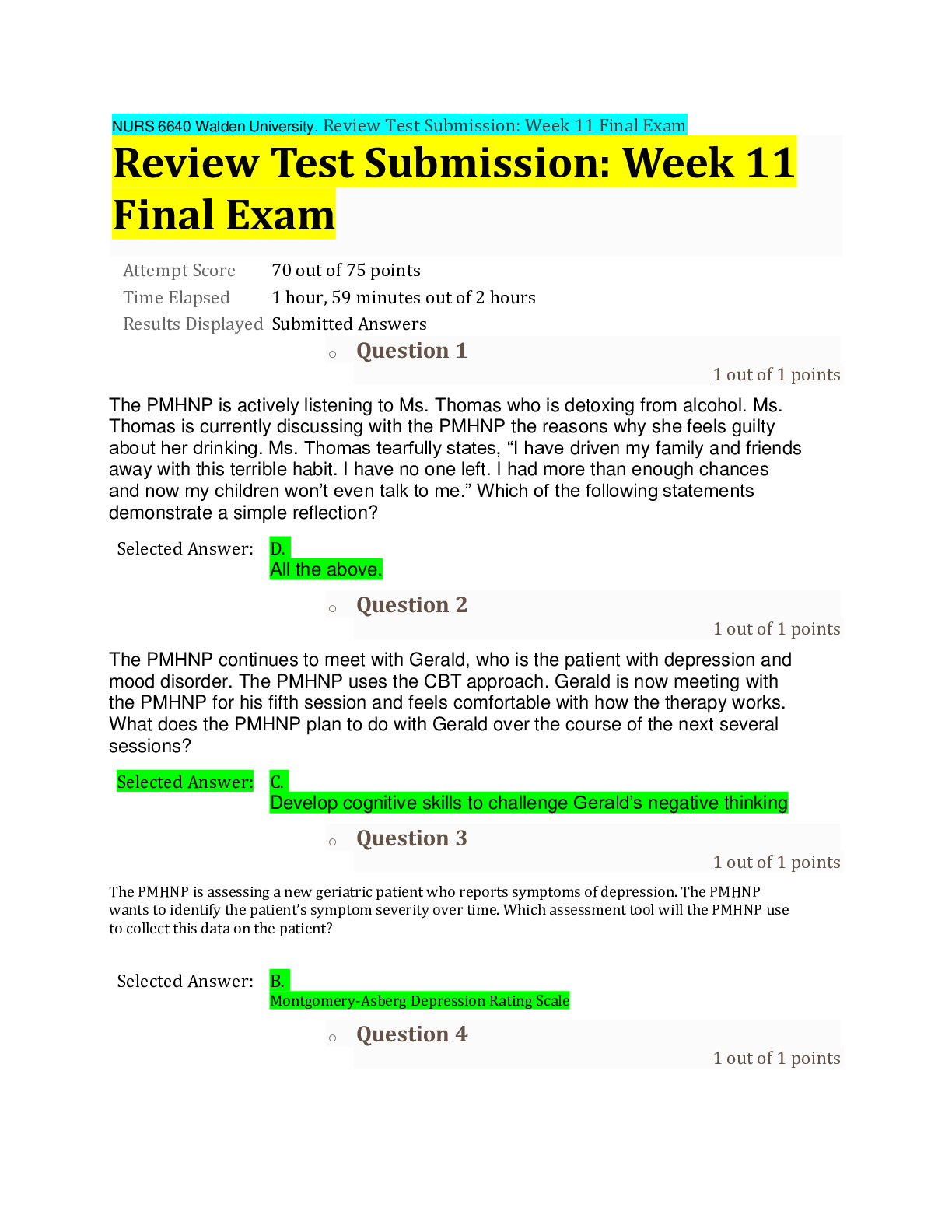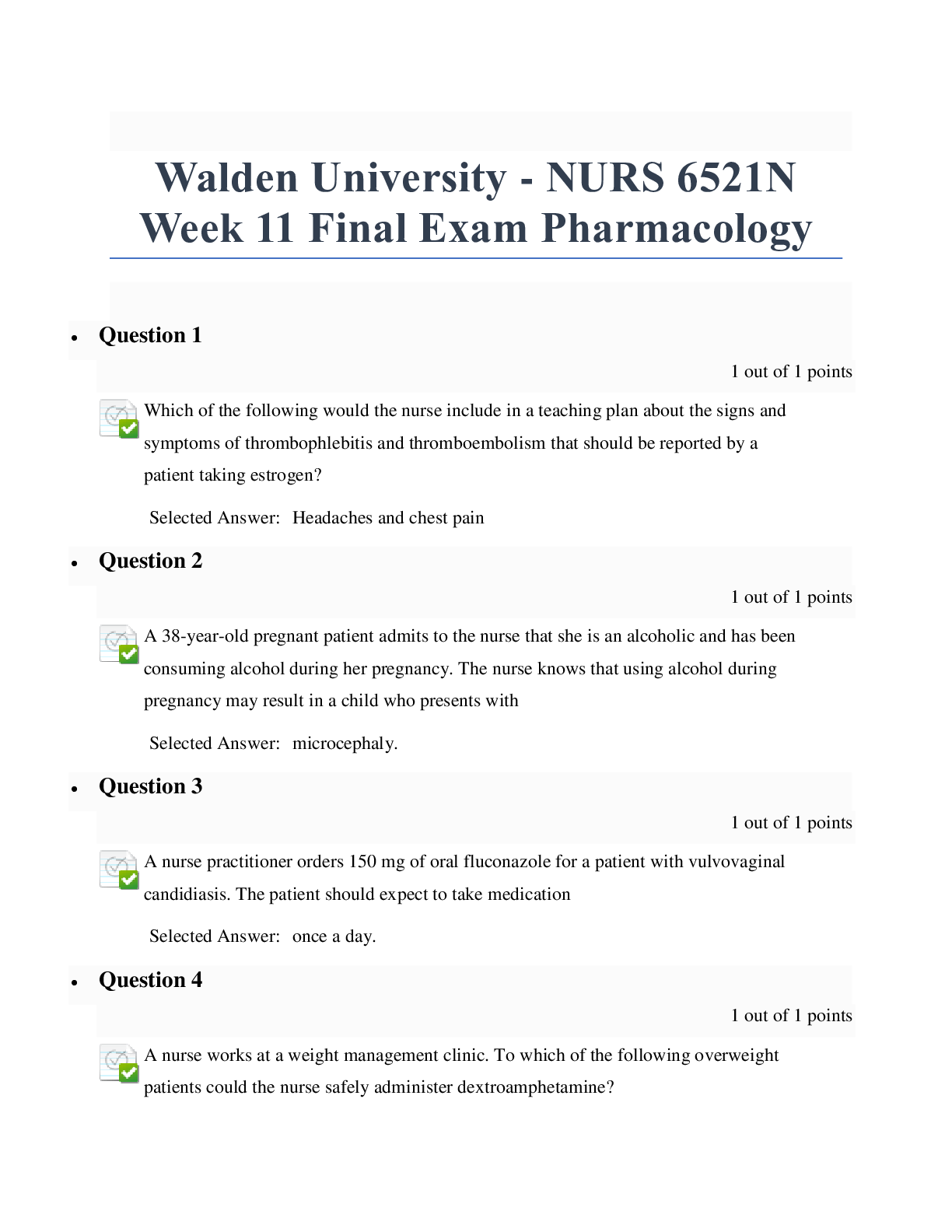NURS 6660 Week 11 Final Exam (Already Graded A) ; Questions and Answers
Document Content and Description Below
NURS 6660 Week 11 Final Exam • Question 1 1 out of 1 points Conventional antipsychotics are not first-line interventions in early-onset schizophrenia due to the risk of dystonic reactions. Ho... wever, when children are not responsive to first-line therapy with atypical antipsychotics, which of the following is the most appropriate conventional choice? Selected Answer: D. Chlorpromazine • Question 2 1 out of 1 points The therapeutic outcomes for children with disorders of written expression are most favorable when they are characterized by: Selected Answer: Intensive, continuous administration of individually tailored, one-on-one expressive and creative writing therapy • Question 3 1 out of 1 points Linda is a 5-year-old girl who has persistent pica; she was finally referred for care when her kindergarten teacher became alarmed by her eating of potentially toxic nonfood substances. Linda’s mother admits during the history that Linda has been doing this for years, but thought it was not a big deal since Linda didn’t eat anything dangerous. Linda’s mother must work two jobs and essentially did not bother to pursue Linda’s unusual symptom because it didn’t seem unsafe. While discussing management strategies with Linda’s mother, the PMHNP counsels that the most rapidly successful treatment strategy appears to be: Selected Answer: A. Aversion therapy • Question 4 0 out of 1 points Rumination is a feeding disorder most commonly seen in infants, but it can occur at any point in the lifespan. Characteristic findings in infants include: Selected Answer: C. Failure to thrive • Question 5 1 out of 1 points Katelyn is a16-year-old girl who presents for therapy with her mother and father. Katelyn was born with male genitalia but has felt like a female “all of her life.” She says she knew something was different as far back as she can remember. She always wanted to wear her mother’s clothes and makeup and play with other girls. Katelyn started dressing and openly identifying as a girl when she was 13 years old, and her parents are trying to be supportive but they are struggling. Most recently Katelyn has developed an intimate partner relationship with Jennifer, a 15-year-old girl who was gender-assigned female at birth and identifies as a female. Katelyn’s father does not understand the relationship. The PMHNP explains that Katelyn: Selected Answer: C. Is a transgender female who identifies as lesbian • Question 6 1 out of 1 points All the following are true with respect to making a diagnosis of major depressive disorder in children except: Selected Answer: C. There must be somatic or psychomotor complaints. • Question 7 1 out of 1 points Donna is a 16-year-old transgender female who has been through extensive individual and family counseling and is ready to start hormone therapy with estrogen, progesterone, and testosterone-blocking agents. When counseling her specifically about the risks, benefits, and required monitoring of hormonal therapy, the PMHNP advises Donna that: Selected Answer: C. Sterility is a probable consequence of hormone therapy • Question 8 1 out of 1 points The leading cause of death in youths living in juvenile residential facilities is: Selected Answer: A. Suicide • Question 9 1 out of 1 points The PMHNP is working with a pediatrician colleague on a journal article to increase awareness and improve diagnostic strategies for early-onset bipolar disorder. Based upon a review of the longitudinal research on this disorder, the literature review of this article should include all the following except: Selected Answer: C. Higher socioeconomic status and lifetime psychosis are predictors of more rapid cycling in early-onset bipolar disorder • Question 10 1 out of 1 points Tiana is a 10-year-old girl who is being referred for evaluation because her school performance is appreciably below what is expected at her age. Historically she has been a very happy child, likes school, and looks forward to going. However, over the last several months her teacher reports that she is much slower than her peers in reading, and she appears to be upset and withdrawn when asked to read in class. The PMHNP would expect additional report from the teacher to include all the following except: Selected Answer: A. Inability to copy correctly from a printed text • Question 11 1 out of 1 points Which of the following statements best characterized the treatment course and progression of bulimia nervosa? Selected Answer: A. Cognitive behavioral therapy is considered the benchmark, first-line treatment. • Question 12 1 out of 1 points Kelly is a 14-year-old female who has finally been referred for management of anorexia nervosa. She was diagnosed almost 1 year ago with the food-restricting subtype, but attempts to get her into psychiatric care were unsuccessful. She continues to be resistant but her caloric intake is now < 400 daily and she finally appears to be unable to sustain the supraphysiologic levels of exercise that she has maintained to try and “keep her weight down.” She is 5’2” tall and weighs 82 lbs., which is approximately 75% of ideal body weight for her height. Her vital signs are stable and surprisingly there are no profound laboratory or ECG abnormalities. When counseling Kelly and her parents about the recommended course of treatment, the PMHNP advises that Kelly will require: Selected Answer: B. Hospitalization for controlled weight gain • Question 13 1 out of 1 points In which demographic is depression twice as prevalent in girls as compared to boys? Selected Answer: C. Adolescents • Question 14 1 out of 1 points Debbie is a 10-year-old female who has been referred to remediation therapy for her reading disorder. While designing her treatment program, the PMHNP knows that the most current strategies are characterized by: Selected Answer: C. Focusing the child’s attention to the connections between speech sounds and spelling • Question 15 1 out of 1 points Which of the following symptom clusters is most likely in a 16-year-old male with major depressive disorder? Selected Answer: D. Pervasive anhedonia, hopelessness, and severe psychomotor retardation • Question 16 1 out of 1 points The etiology of childhood depression is multifactorial and may include biological factors. Which of the following is a true statement with respect to hormonal studies in depressed children? Selected Answer: A. Prepubertal children having a depressive episode secrete significantly more growth hormone during sleep than nondepressed children. • Question 17 1 out of 1 points Jared is a 6-year-old boy who comes to the PMHNP for an evaluation with his father. The father reports that he is worried about Jared because he has had problems fitting in at school ever since he started kindergarten. He does not have any friends at school and does not seem to know how to play with others. Dad reports that Jared has never been “very talkative” and sometimes switches from one topic to another without any reason. When considering early-onset schizophrenia, the PMHNP recognizes that which of the following must be present? Selected Answer: B. Deteriorating function over the last several months • Question 18 1 out of 1 points Learning disorders affect at least 5% of all school-aged children in the United States. Since 1975, Public Law 94-142 mandates that all states provide free, appropriate services to all children. Among the various types of learning disorders, the PMHNP knows that the overwhelming majority are: Selected Answer: A. Reading disorders • Question 19 1 out of 1 points While the core features of schizophrenia are essentially the same in children as they are in adults, the presentation or characterization is sometimes very different given developmental issues. Unlike adults with schizophrenia, children with schizophrenia do not have: Selected Answer: B. Poverty of speech content • Question 20 1 out of 1 points The PMHNP is working with rural primary care providers to increase awareness of mental health disorders in infancy and early childhood. The program includes a session on screening for feeding disorders in infants. If an infant is either observed by the provider or reported by the parent to frequently suck the tongue rhythmically or appear to strain with his or her back arched and then swallow, the examiner should consider the possibility of: Selected Answer: D. Inadequate emotional attachment .........CONTINUED [Show More]
Last updated: 2 years ago
Preview 1 out of 20 pages
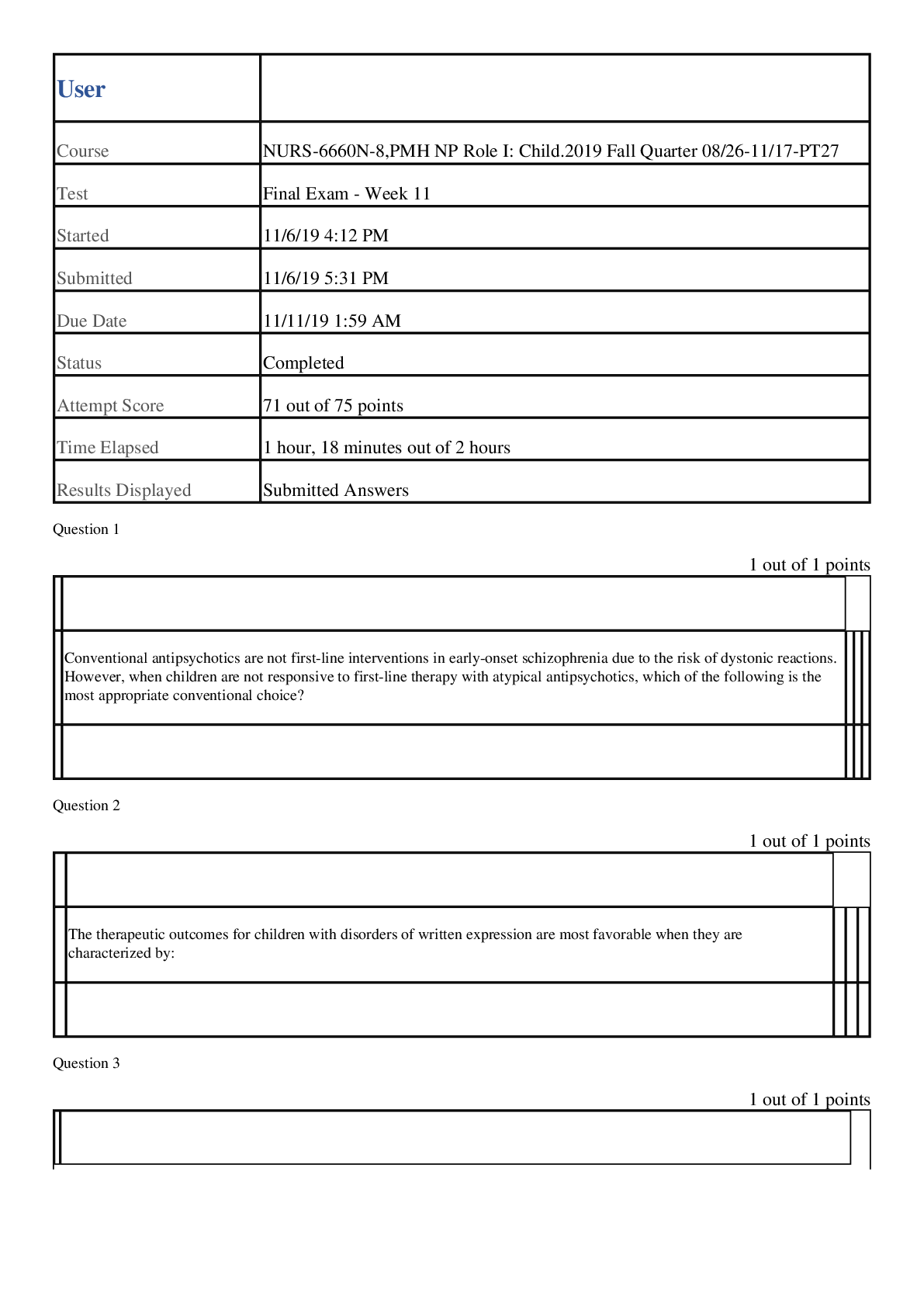
Buy this document to get the full access instantly
Instant Download Access after purchase
Buy NowInstant download
We Accept:

Also available in bundle (1)

NURS 6660 Final Exams (Questions and Answers)
NURS 6660 Final Exam NURS 6660 Week 11 Final Exam
By YourTutor 4 years ago
$35.5
2
Reviews( 0 )
$20.50
Can't find what you want? Try our AI powered Search
Document information
Connected school, study & course
About the document
Uploaded On
Jan 28, 2021
Number of pages
20
Written in
Additional information
This document has been written for:
Uploaded
Jan 28, 2021
Downloads
0
Views
86













